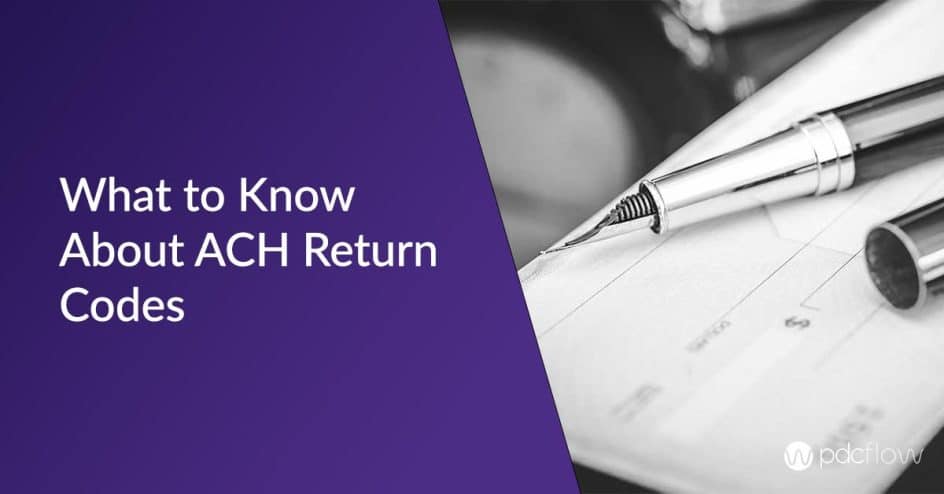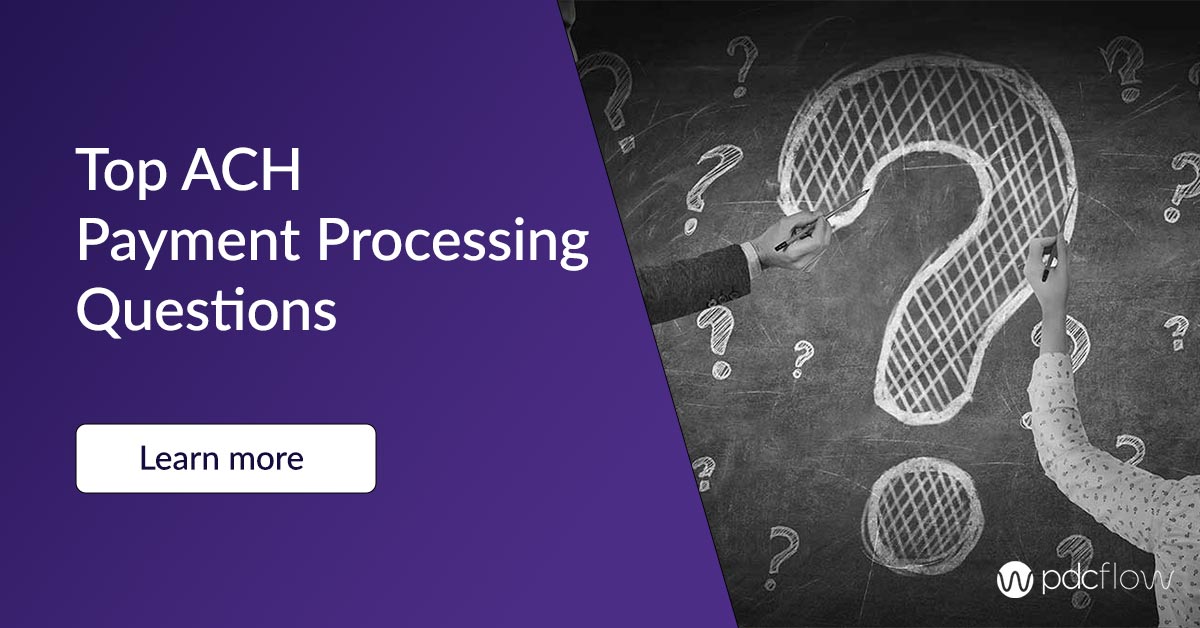Accepting Automated Clearing House (ACH) payments can provide added convenience to customers during the payment process while increasing revenue for your business. Unfortunately, no payment method is without hurdles.
In the case of ACH payments, the most common hurdle to overcome is understanding and addressing ACH codes for returned payments.
There are many ways an ACH transaction might get returned. Sometimes it is due to simple human error, and sometimes a more complicated issue arises.
ACH returns cause you to:
- lose out on revenue
- rack up ACH return fees with your processor
- and can raise your return rate above the levels designated by Nacha.
Nacha is the organization that oversees the ACH network (risking a forced shut off of your ACH processing).
What is Nacha?
Nacha governs the ACH Network, the payment system that drives Direct Deposits and Direct payments.
Nacha develops the rules that allow Direct Deposits and ACH bill payments.
Some ACH returns are inevitable, but many can be either minimized or prevented.
Below is a list of some common administrative ACH return codes and uncommon codes (considered by payment processors to be chargebacks).
ACH Return Codes Related to Administrative Failures
- R02 ACH return code: Account Closed
- R03 ACH return code: No Account/Unable to Locate Account - This code can mean that the banking information does not match the customer’s name, or it can indicate that the account number doesn’t correspond to any open account.
- R04 ACH return code: Invalid Account Number - This ACH return reason means there is something wrong with the bank account information, such as an incorrect amount of digits in the account number.
ACH Return Codes for
Administrative Failures
R02 – Account Closed
R03 – No Account/Unable to Locate Account
R04 – Invalid Account Number
To reduce the number of administrative codes you receive for your ACH payments, use dual account entry.
This is an option that requires consumers to type their account number twice for the purpose of ACH bank account verification during online payments. This system setting is a good defense against simple human errors such as typos.
ACH Return Codes Applied to Overall Return Rate
Although any ACH return is going to count toward an overall return rate, these are the most common ACH return reason codes.
- R01 ACH return code: Insufficient Funds - This return code is the most frequent return code seen, and means the consumer did not have enough funds in their account when the ACH transaction was presented to their financial institution.
Unlike credit and debit card payments, ACH transactions are not a real-time payment method. When your employee enters the payment information, there is no way to determine if the required funds are available. You must wait until the payment is batched out and sent into the ACH network. Ultimately, you have to trust that your consumer will have the funds necessary in their account.
- R06 ACH return code: Returned per ODFI Request - Originating Depository Financial Institution (ODFI) has requested Receiving Depository Financial Institution (RDFI) to return the ACH entry.
- R08 ACH return code: Payment Stopped - The receiver of a recurring debit transaction has stopped payment on a specific ACH debit. RDFI should verify the receiver's intent when a request for stop payment is made to ensure this is not intended to be a revocation of the authorization.
- R09 ACH return code: Uncollected Funds - There is enough money in the bank account to cover the transaction being presented, but the money is not yet available. This is referring to the bank account's current balance and available balance.
- R14 ACH return code: Account Holder Deceased - Account holder is deceased.
- R16 ACH return code: Account Frozen - Funds are not available due to a specific action by the RDFI or by legal action.
- R20 ACH return code: Non-Transaction Account - indicates that the account provided is not set up for transactions, or the transaction type it can perform isn’t the type being attempted. Typically this is the result of entering a savings account number instead of a checking account number.
ACH Return Codes Applied to the Unauthorized Debit Entries Return Rate
The ACH return codes below are a few which indicate a payment is being blocked. These codes are considered chargebacks and often rack up a higher ACH return charge with your payment processor.
Chargebacks indicate the consumer has told their financial institution they did not authorize an ACH transfer. The financial institution is obligated to immediately return the ACH transaction and refund the monies into the consumer’s account.
This might happen if the spouse of the consumer wasn’t aware of the transaction and didn’t recognize it on their bank statement.
Another common reason for an ACH return is if the description on the bank statement doesn’t match your business name.
- R05 ACH return code: Unauthorized Debit to Consumer's Account - Account number structure was not valid. The debit presented used a Corporate SEC code.
- R07 ACH return code: Authorization Revoked - Consumer who had previously authorized ACH debits has revoked their authorization. Funds must be returned no later than 60 days from settlement date and customer must sign an affidavit.
- R10 ACH return code: No Authorization/Customer Says: Not Authorized/Improper/Ineligible - Consumer has advised RDFI that the originator of the transaction is not authorized to debit the account. Funds must be returned no later than 60 days from the settlement date of original entry and the customer must sign an affidavit.
- R29 ACH return code: Corporate Not Authorized - RDFI has been notified by the receiver (non-consumer) that the entry was not authorized.
- R51 ACH return code: RCK Entry: Related Item Ineligible/Entry Improper - Item is Ineligible, Notice Not Provided, Signatures Not Genuine, Item Altered or Amount of RCK Entry not Accurately Obtained From the Item.
ACH Return Codes for
Unauthorized Returns
R05 – Unauthorized Debit to Consumer's Account
R07 – Authorization Revoked
R10 – No Authorization/Customers Says: Not Authorized/Improper/Ineligible
R29 – Corporate Not Authorized
R51 – RCK Entry: Related Item Ineligible/Entry Improper
Best Practices to Avoid ACH Returns
These types of unauthorized ACH return codes can often be avoided with these simple best practices in place:
- Confirm the description which appears on bank statements matches your business name.
- Be sure to have your payment representatives inform the consumer of how the descriptor will appear on their statement.
- Include a customer service number along with your business name on all payment receipts and communications with the consumer. It is better to have the consumer call you first rather than call their financial institution and revoke their authorization.
- Make sure your customer service phone is answered consistently and a voicemail is in place identifying your business, your hours of operation, and the best method for contacting your office again.
What To Do After Receiving An ACH Return
After receiving an ACH return code, the first step your office should take is to contact the customer who made the payment if at all possible. With administrative codes such as insufficient funds or an invalid account number, you may be able to clear up the issue and try to process the payment again.
In the case of a chargeback code, you can narrow down the source by first researching what the ACH code indicates, then speaking to the consumer.
If they are not blocking the payment, that means there is an issue originating from one of the banks being used for the transaction. You or your consumer will need to speak to the bank to clear up what is blocking the payment.
Once the problem is discovered, speak to your payment processor. They will also have to speak to the ACH processing service your office uses to ensure the payment is unblocked in their system as well.
Proof of Authorization
NACHA APPROVED REASONS TO DISPUTE A TRANSACTION
- If a charge was never authorized by the account holder or the authorization was revoked.
- If it was processed on a date earlier than authorized.
- If the transaction amount charged differs from the amount authorized.
ACH TRANSACTION TYPES
Getting the correct proof of authorization (POA) for each ACH type your business accepts is important. POAs protect your business so consumers cannot reverse transactions.
Beyond this, POAs are a NACHA requirement and must be adhered to in order to continue processing ACH payments.
- PPD: A one-time or recurring business-to-consumer ACH transfer requires a written authorization or "wet" signature.
- TEL: A one-time or recurring ACH transfer taken over the phone requires either a notice prior to debit or a recorded call. If you enter the email when taking the payment over the phone, PDCflow automatically sends the notice prior to debit on your behalf.
- WEB: A one-time or recurring ACH processed via a website requires input that validates identity, permission to debit, and revocation language.
- CCD: A one-time or recurring business-to-business ACH payment requires written authorization or a "wet" signature.
Subscribe for weekly updates or PDCflow’s monthly newsletter to stay up to date with resources and strategies to help you improve the payment experience for your customers and create a better cash flow for your business.





